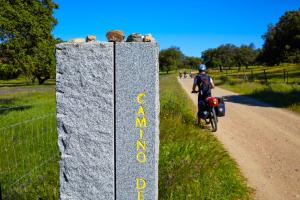Camino Primitivo Walking Guide
The entire Way of St. James began with the Primitive Way.
As legend has it, in the 9th century the bones of the apostle St. James appeared, after being killed in Palestine, in what was known as the kingdom of Galicia. The news did not take long to spread among devout Christians until it reached the ears of King Alfonso II of Asturias, who did not hesitate to start a journey to see the remains of St. James with his own eyes.
The Camino Primitivo starts in Oviedo and ends in Santiago de Compostela, crossing the centre of Asturias and Galicia. It is the most mountainous route and passes through sparsely populated areas with a rural and mountain gastronomy that is of the highest quality and delicious. Although there are not many pilgrims, there are enough to keep accommodation and services open. If you are looking for a quieter Camino, or a physical challenge, walking the Camino Primitivo is a very good option.
History of the Camino Primitivo
The Primitive Way is the oldest route of the Camino de Santiago, with a history dating back to the 9th century. It is considered the first Camino, inaugurated by King Alfonso II of Asturias, who made the first pilgrimage when he heard that the remains of the Apostle Santiago had been found in Santiago de Compostela.
This route, which crossed the mountains of Asturias and Galicia, was considered a demanding route with unpredictable weather, but at the same time a safer route while part of the Iberian Peninsula was under Muslim control. As northern Spain became more stable, the Primitive Way lost popularity to the French Way, which was easier and had a better infrastructure for pilgrims.
Today, the Camino Primitivo has not lost its historical relevance and is experiencing a resurgence, attracting hikers who prefer mountainous terrain, a cooler climate or who seek a more solitary experience.
Location
Starting in Oviedo, the Primitive Way immerses you in a few kilometres in a mountainous landscape full of valleys and villages that go back in time. It crosses western Asturias as far as Fonsagrada, now in Galicia, and after passing the city of Lugo, it joins the French Way in the town of Melide.
Map
Have a look at the map to see exactly where you start, pass through, and finish the Camino Primitivo route.
Starting and finishing points
The Camino Primitivo begins in the Gothic cathedral of Oviedo (Uviéu in Asturian), capital of Asturias, and ends in the cathedral of Santiago de Compostela, Galicia.
Distance and length of the stages
A total of 310 km (192 miles) divided into 15 stages of between 15 and 25 km (10 - 15 miles) per day. You may encounter climbs of between 150m and 970m, although the average is between 250m and 600m.
Difficulty
The Camino Primitivo has medium-high difficulty due to some quite demanding stages, especially in the first few days. As you head towards Galicia, on a couple of occasions you will have to climb more than 700 m to reach the Puerto del Palo or the Alto del Acebo.
The second half becomes gentler, especially as you get closer to Santiago.
Check the elevetaion profile in the image below.
The route
The beginning of the Primitive Way has a value in itself, the city of Oviedo, with a strong historical and patrimonial weight. Shortly after leaving the city, the route takes you right into a wooded area, with meadows enclosed by stone walls, open hillsides with brañas (high pastures with stone huts) and a sparse population. There are not many options for accommodation in this area, but the boom of recent years has led to the emergence of small hotels and rural houses with a hospitality that is gradually gaining recognition.
Get your strength back at the La Allandesa restaurant eating their locally sourced beef stuffed cabbage, because from there the terrain starts to test your legs as you go over the Puerto del Palo or the Alto del Acebo. The climb is part of the Camino, and the views are a reward. This area is known for its hospitals (former hostels for pilgrims who were surprised by fog or bad weather). Imagine their relief to find the door open when walking in the middle of the night with wolves howling in the distance. These days, you may hear wolves, but you will not encounter any; so, all you need to be prepared for is the unpredictable weather conditions.
And you're already halfway between Asturias and Galicia! These days you can expect gentler routes, crossing rural areas with a wealth of natural beauty and a curious yet somewhat dark architecture, based on granite and slate tiles.
The Camino will remain quiet until, in about 4-5 days, you will find yourself in Melide with the pilgrims following the French Camino route. Suddenly you find yourself in Monte do Gozo, from where you can see the cathedral of Santiago, only 4km away. Stop and enjoy the moment and, when you are ready, cross the city and celebrate the Camino in the Plaza del Obradoiro.
.png) |
.png) |
Accommodation
Apart from the two cities through which this route passes (Oviedo and Lugo), the accommodation you can find on the Primitive Way are small rural hotels, rural houses and hostels for pilgrims, with a limited number of rooms. If you are looking for something more special, in a nearby village you can find a Casona (Asturias) or a pazo (Galicia), historic manor houses, which have been converted into upscale accommodation and accept pilgrims out of high season. Sleeping in one of these buildings is a leap back in time.
Weather and best time to walk the Camino Primitivo
The Camino Primitivo is one of the highest routes (up to 1,168m at the Alto del Acebo), and the temperature is noticeable, especially in winter. You also have to take into account the snow, which can be found in some places between October and April. Whereas, it can get quite hot in the valleys in summer.
But to do this Camino you have to consider another setback: accommodation. These are usually closed from mid-October to April, so the best time to do the Camino Primitivo is between April and mid-July, and in September and October.
How to get there
The Primitive Way begins in Oviedo, a city that has greatly improved its transport links in recent years, both by land and by air.
By plane
There are several domestic flights, and the frequency and destinations are increasing. If you are coming from a long international flight, you will probably land in London, Paris or Madrid. From there you can take a flight to Oviedo airport.
From Santiago, you will find several national and international flights, and you can also check the airport of A Coruña, less than 1 hour away by car.
By train
Oviedo has recently been connected to Madrid by high-speed train (Ave), but there are also connections with other trains to cities such as Barcelona, Alicante, Santander or Seville.
By bus
The boom of bus companies with international routes connects Oviedo with the rest of Spain or Europe. The biggest companies are ALSA, Eurolines, Flix, Ouibus, ...
5 Sites not to be missed
Castro Chao, in San Martín (Asturias), which dates from the Bronze Age, around 800 BC. You can find more information in the museum just a few metres away.
The Vaqueira culture. The Vaqueiros were transhumant shepherds, who moved back and forth between their summer and winter villages (the so-called brañas). They were a people marginalised by sedentary people because of their different origins and traditions. You can detect the passing of this people in the area of Tineo and, if you are lucky, hear a vaqueirada in a popular festival in the area.
The Pre-Romanesque Museum of San Martín de Salas (Asturias), with a sample of pieces in very good condition and a good representation of the Asturian workshops of the 10th century.
The city of Lugo (Galicia). If you have any strength left when you get to the city, we recommend you walk along the Roman wall that surrounds the historic centre. It is about 2.3 km long and is well worth it for the views of the city from the top.
Advice from S-Cape Travel
Keep in mind that the shells that indicate the Camino can change direction when crossing from Asturias to Galicia. This was done in the past so that ‘false’ pilgrims could not follow the Camino. But don't panic, nowadays most of the shells are accompanied by an arrow so that, whether you are a ‘real’ pilgrim or not, you will arrive in Santiago.
Marketing, Web & Design
After studying in my hometown of Barcelona and spending several years abroad, I relocated in 2018 to Cabrales, a beautiful rural area in Northern Spain. I invite you to check out some photos of Cabrales to see the incredible views we enjoy from our office!
After a few years in reservations, I now manage the website and marketing for S-Cape Travel, where I handle design tasks, blog writing, and attend specialized travel fairs.










Opening hours: Mon-Fri 9:00am – 6:00pm (CET)
Opening hours: Mon-Fri 9:00am – 6:00pm (CET)